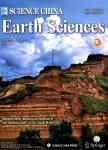Late Cenozoic uplift of the Liupan Mountains:Evidence from the Neogene loess deposits
作者机构:Key Laboratory of Cenozoic Geology and EnvironmentInstitute of Geology and GeophysicsChinese Academy of SciencesBeijing 100029China Institute of GeomechanicsChinese Academy of Geological SciencesBeijing 100081China CAS Center for Excellence in Life and PaleoenvironmentBeijing 100044China University of Chinese Academy of SciencesBeijing 100049China Institute of Ecological Geology Survey and Research of Heilongjiang ProvinceHarbin 150030China School of Geography and Information EngineeringChina University of GeosciencesWuhan 430078China School of Earth SciencesChina University of GeosciencesWuhan 430074China Natural Resources Survey Institute of Heilongjiang ProvinceHarbin 150036China
出 版 物:《Science China Earth Sciences》 (中国科学(地球科学英文版))
年 卷 期:2024年第67卷第5期
页 面:1480-1488页
核心收录:
学科分类:070904[理学-构造地质学] 0709[理学-地质学] 07[理学] 0708[理学-地球物理学]
基 金:supported by the National Natural Science Foundation of China(Grant No.42488201) the Strategy Priority Research Program(Category B)of Chinese Academy of Sciences(Grant No.XDB0710000)。
主 题:Liupan Mountains Mountain building Neogene Loess Chinese Loess Plateau Late Miocene Late Oligocene–early Miocene
摘 要:The Liupan Mountains,one of the important mountain ranges in western China,are located on the boundary between the northeastern Tibetan Plateau and the Ordos Block.The uplift history of the Liupan Mountains remains controversial.Loess deposits are good tracers of regional tectonic and geomorphic changes,because loess is sensitive to erosion and the formation and preservation of loess requires relatively flat highlands and relatively stable tectonic environments.We investigated the distribution of Neogene loess deposits on the western piedmont of the Liupan Mountains and examined a near-continuous loess section(Nanping section)on the piedmont alluvial highlands.Correlation of magnetic susceptibility stratigraphy with the QA-ⅠMiocene loess sequence dates this 56-m section covering the interval from~8.1 to 6.2 Ma.The lower boundary age of this section,together with previously reported Zhuanglang red clay(sand-gravel layers with intercalated loess during~9–8 Ma and near-continuous loess during~8–4.8 Ma)and Chaona red clay(~8.1–2.58 Ma),indicates that the Liupan Mountains were uplifted in the late Miocene(~9–8 Ma)and basically formed by~8 Ma,attesting to no intense mountain building since that time.In addition,based on the information from the Zhuanglang core and the QA-Ⅰsection,we infer that sizable parts of the Liupan Mountains were uplifted during the late Oligocene–early Miocene and did not experience intense uplift during~22–9 Ma.



